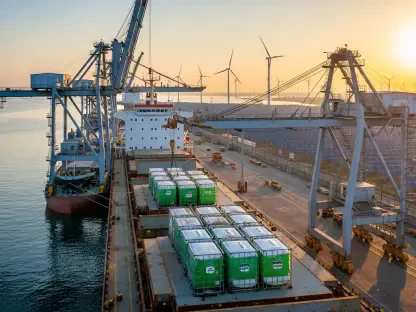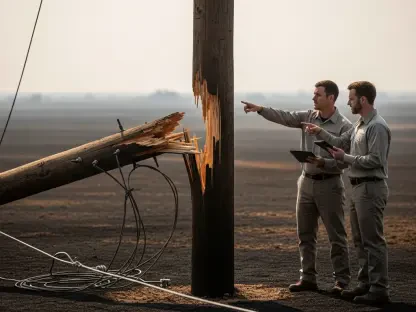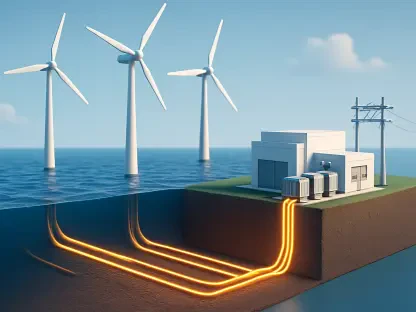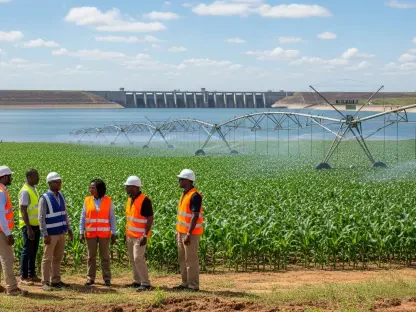Climate change is more than just a rising thermometer; it’s a catalyst for a complex web of challenges, particularly in terms of energy hardship. In Australia, both extreme heat and cold are straining household budgets, creating a precarious situation especially for the most vulnerable. As we grapple with this reality, a better understanding of how extreme temperatures impact energy affordability can guide us toward more effective solutions.
Australia’s climate is experiencing unprecedented changes, marked by more extreme heatwaves and cold snaps. These fluctuations have far-reaching implications, particularly in the realm of energy affordability. With temperatures soaring to unprecedented highs and plummeting to unusual lows, many Australian households find themselves in a difficult position, struggling to maintain indoor comfort without breaking the bank. This article delves into the complexities of energy hardship in the wake of climate extremes, utilizing comprehensive data and projections to underscore who is most at risk and what measures can be taken to mitigate this emerging crisis.
The Nexus Between Climate Change and Energy Hardship
Defining Energy Hardship
Energy hardship occurs when households cannot afford the energy required to maintain a healthy indoor environment. This phenomenon is influenced by several factors, including high energy costs, low income, and inadequate housing. When temperatures veer towards the extreme, the need for artificial heating or cooling becomes indispensable, significantly impacting household budgets.
Households facing energy hardship are unable to achieve a basic standard of thermal comfort, which is essential for health and well-being. The necessity to run heating or cooling systems to cope with these temperature extremes leads to increased energy consumption, which can take up a significant portion of household income. In some instances, families are forced to forego other essential expenses, such as food and healthcare, to manage rising energy bills.
Metrics and Indicators
Energy hardship is measured through various indicators, such as the percentage of household income allocated to energy costs. Another key metric is the proportion of households spending over 10% of their income on energy, a threshold commonly used to identify those experiencing serious financial strain due to energy costs.
Additionally, the Low-Income High Cost (LIHC) metric takes into account both energy costs and the residual income left after these expenses are paid, identifying households that have high energy costs relative to their income. Incidences of utility payment arrears due to financial constraints further underscore the severity of energy hardship. These metrics collectively provide a clear picture of the financial strain experienced by households as they endeavor to maintain a comfortable living environment amidst extreme weather conditions.
Extreme Temperature Metrics
Understanding Temperature Extremes
Australia’s climate volatility is captured through metrics like the Excess Heat Factor (EHF) and Excess Cold Factor (ECF), which assess the intensity, frequency, and duration of heatwaves and cold snaps. These metrics are designed to analyze both short- and long-term anomalies in temperature, providing a comprehensive view of climate extremes. Daily average temperatures, derived from daily maximum and minimum values, also serve as crucial indicators to understand the overall distribution of temperature changes.
The rising global temperatures are causing more frequent and prolonged heatwaves, interspersed with unusual cold snaps. These fluctuations exacerbate energy demands, particularly in regions unaccustomed to such extremes, thereby amplifying the risk of energy hardship. This growing instability in temperature patterns makes it increasingly challenging for households to manage energy consumption and costs effectively.
Climate Change and Temperature Distribution
The influence of climate change on temperature distribution is evident as maximum temperatures continue to rise while minimum temperatures drop, leading to more significant gaps between day and night temperatures. This creates a dual challenge for households, as they must manage higher energy costs for cooling during the daytime and heating during the nighttime.
These extreme variations in temperature force households to rely heavily on energy to maintain indoor thermal comfort. Areas previously unaccustomed to such extremes are now facing new challenges, as their infrastructure may not be designed to cope with sudden spikes or drops in temperature. This highlights the pressing need for adaptive measures to address the evolving patterns of energy consumption due to climate change.
The Impact of Extreme Temperatures on Energy Hardship
Heatwaves: A Growing Menace
Increasing Intensity and Frequency
Australia is witnessing a surge in the intensity and frequency of heatwaves, with maximum temperatures climbing higher each year. As these extreme heat events become more common, they drive up energy consumption as households run air conditioners and fans relentlessly to combat the sweltering heat. Consequently, energy bills skyrocket, pushing more families into financial distress. The financial burden of cooling homes during prolonged heatwaves is particularly acute for low-income households, which often lack the resources to invest in energy-efficient cooling systems.
This escalation in energy demand during heatwaves not only strains household budgets but also places immense pressure on the national energy grid. The increased load can lead to power outages and higher energy prices, further compounding the difficulties faced by those already struggling with energy hardship. The cycle of rising energy costs and increasing consumption creates a feedback loop, making it even harder for vulnerable households to break free from financial distress.
Prolonged Duration and Economic Burden
Extended periods of extreme heat further exacerbate the situation. The longer a heatwave lasts, the more energy is consumed, and the greater the strain on household budgets. This duration-linked economic burden creates a cycle of hardship, particularly for those with already limited financial resources. Prolonged heatwaves not only increase energy consumption but also lead to higher maintenance costs for cooling systems, adding another layer of financial stress.
These extended heat events also have broader social and economic impacts. Vulnerable populations, including the elderly and young children, face higher health risks during prolonged heatwaves, which can lead to increased medical expenses and lost productivity. The economic burden of extended heat events is therefore multifaceted, impacting not just household finances but also the overall well-being of communities.
Cold Snaps: An Underestimated Threat
Frequency and Intensity in Warmer Regions
While heatwaves dominate the conversation around climate change, cold snaps remain a significant yet often overlooked threat. In warmer parts of Australia, where homes are less likely to be equipped for cold weather, sudden temperature drops can lead to unexpected energy spikes as households scramble to heat their living spaces. These regions are particularly vulnerable as their infrastructure and housing designs are often ill-suited for maintaining thermal comfort during cold snaps.
Even a brief period of unusually cold weather can lead to a sharp increase in heating costs, catching many households off guard. The lack of proper insulation or energy-efficient heating systems in these homes exacerbates the problem, making it difficult for residents to maintain a comfortable living environment without incurring high energy expenses. This highlights the need for region-specific strategies to address the unique challenges posed by cold snaps.
Economic Strain Across All Regions
Even in traditionally cooler areas, unexpected cold snaps can strain household budgets. The need for continuous heating during these periods can lead to unanticipated spikes in energy bills, further pushing families into financial difficulty. In regions where residents are more accustomed to cold weather, the sudden intensity and prolonged duration of cold snaps can still pose a significant economic challenge.
Households in these areas may already operate on tight budgets, and additional energy costs can push them over the edge into energy hardship. The cumulative effect of frequent and intense cold snaps over the winter season can lead to sustained financial strain, making it difficult for families to recover. Addressing the economic impact of cold snaps requires a comprehensive approach that includes improving housing insulation, offering financial assistance for energy costs, and promoting energy-efficient heating solutions.
Vulnerability and Socio-Demographic Factors
Age and Energy Expenditure
Higher Risks for Older Adults
Older adults are particularly vulnerable to energy hardship during extreme temperatures. Due to their physiological needs and typically fixed incomes, this demographic faces a higher risk when temperature fluctuations necessitate increased energy consumption. The elderly often require more stable and comfortable indoor temperatures to maintain their health, leading to higher energy use for heating and cooling.
This increased energy expenditure can quickly become a financial burden for older adults, many of whom live on limited pensions or savings. The challenge is compounded by the fact that older homes, where many elderly individuals reside, are often less energy-efficient, leading to higher energy bills. This demographic is thus doubly disadvantaged, facing both increased energy needs and higher costs to meet those needs, making them particularly susceptible to energy hardship during extreme weather events.
Middle-Aged Households and Payment Arrears
Middle-aged individuals, often managing multiple financial responsibilities, are more prone to falling behind on utility payments during extreme temperature events. This group may experience significant financial stress, leading to higher incidences of utility payment arrears. The dual burden of supporting dependent children and aging parents, coupled with mortgage or rent payments, leaves middle-aged households with limited financial flexibility to absorb unexpected spikes in energy costs.
The financial strain of managing increased energy consumption during extreme temperatures can lead to difficult choices, such as deciding between paying utility bills or meeting other essential expenses. This demographic is often stretched thin, making it more likely that they will fall behind on utility payments, accruing late fees and further compounding their financial difficulties. Addressing the unique challenges faced by middle-aged households requires targeted support to help them manage their energy costs without compromising their overall financial stability.
Household Composition and Living Arrangements
Lone Parents and Single-Person Households
Lone parents and single-person households are disproportionately affected by energy hardship. The lack of additional income sources in these living arrangements makes it difficult to absorb increased energy costs, rendering them particularly vulnerable during extreme weather events. Single-income households often have limited financial reserves, making it challenging to manage unexpected spikes in energy bills caused by extreme temperatures.
For lone parents, the financial burden is even greater, as they must also meet the needs of their children. Balancing the cost of heating or cooling their home with other essential expenses, such as food and education, becomes a significant challenge. These households are more likely to experience utility payment arrears or be forced to make sacrifices in other areas of their lives to manage their energy costs, highlighting the need for targeted support.
Group and Multi-Family Households
Group and multi-family households, while having the potential for shared financial responsibilities, also face unique challenges. The need to accommodate diverse thermal comfort preferences can lead to higher overall energy consumption, amplifying financial strain. Multiple individuals or families living under one roof may have differing needs for heating and cooling, leading to increased use of energy to maintain a comfortable environment for everyone.
The larger size of group and multi-family households also means that they consume more energy overall, leading to higher utility bills. Coordinating energy use and managing costs can be complex, creating additional stress and financial difficulty. These households may benefit from targeted energy efficiency programs and financial assistance to help manage their energy consumption and costs effectively, ensuring that all members can maintain a comfortable living environment without undue financial strain.
Housing Quality and Tenure
Renters at Higher Risk
Renters, especially those in low-quality housing, face heightened risks of energy hardship. They often have little control over the energy efficiency of their homes, making them more susceptible to high energy costs. Renters are less likely to invest in energy-efficient upgrades, such as insulation or modern heating and cooling systems, due to the temporary nature of their living arrangements.
Landlords may also be reluctant to make these investments, leaving tenants to bear the brunt of increased energy costs during extreme weather events. This lack of control over their living conditions, coupled with potentially higher bills, puts renters in a particularly precarious position. Policies aimed at improving the energy efficiency of rental properties and offering financial assistance to renters can play a crucial role in mitigating energy hardship in this demographic.
Addressing Housing Quality and Energy Efficiency
Improving the energy efficiency of homes is a critical strategy for reducing energy hardship. Poorly insulated homes or those with outdated heating and cooling systems require more energy to maintain comfortable temperatures, leading to higher utility bills. Homeowners and landlords should be encouraged or incentivized to make energy-efficient upgrades, such as installing better insulation, energy-efficient windows, and modern HVAC systems.
Government programs that offer grants or low-interest loans for energy efficiency improvements can make it more feasible for households to invest in these upgrades. Such measures not only help reduce energy costs but also contribute to a more sustainable and resilient housing stock. Ensuring that rental properties meet energy efficiency standards can also protect tenants from the financial strain of high energy bills, creating a more equitable living environment for all.
Conclusion
The impact of climate change on temperature distribution is becoming increasingly evident. As maximum temperatures continue to rise during the day while minimum temperatures drop at night, a larger discrepancy between day and night temperatures is emerging. This shift creates a dual challenge for households, which now face higher energy costs for both cooling in the daytime and heating at night.
Households are forced to rely more heavily on energy to maintain indoor comfort due to these extreme temperature swings. This issue is particularly problematic for areas that previously didn’t experience such variations; their infrastructure may not be equipped to handle sudden spikes or drops in temperature. This situation underscores the urgent need for adaptive measures to address the changing patterns of energy use driven by climate change.
Furthermore, the increased energy demand for heating and cooling strains existing energy resources and can lead to higher greenhouse gas emissions, exacerbating the problem of climate change. As cities and communities strive to cope with these new challenges, there’s a growing need for innovative solutions, such as improved building insulation, smart thermostats, renewable energy sources, and public policies aimed at energy efficiency. In essence, the evolving climate patterns not only demand individual action but also collective efforts at the societal level to mitigate the impacts and create sustainable living conditions.









